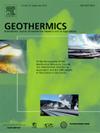Constraints of hydrochemical and geological controls in deep-circulation geothermal systems: Insights from Chengde, Dehua, and Tashkorgan geothermal fields in China
IF 3.5
2区 工程技术
Q3 ENERGY & FUELS
引用次数: 0
Abstract
Controlled by the collision of the Indian–Eurasian Plate and the subduction of the Pacific–Philippine Plate into the Eurasian Plate, deep-circulation geothermal resources are widely developed on the Tibetan Plateau in western China, the Yanshan Mountains in northern China, and the coastal region in southeastern China. However, the hydrochemical and lithospheric thermal–structural responses under different geological and tectonic background conditions are currently unknown, which constrains our understanding of the factors controlling the genesis of low- to medium-temperature deep-circulation geothermal systems. In this study, the deep-circulation geothermal systems of Chengde in Northern China, Dehua in Southern China, and Tashkorgan on the Pamir Plateau in Northwestern China were investigated. Geothermal systems in the Pacific tectonic domain at the eastern margin of the Eurasian Plate have similar elemental geochemistry and hydroxide isotopic characteristics with differences in major anion types and reservoir temperatures, which may be attributed to differences in fluid circulation depths along the fracture networks in the geothermal systems. The geothermal systems in the Tethys tectonic domain, caused by the collision of the Indian and Eurasian Plates, differ significantly from those in the Pacific tectonic domain, with more complex hydrochemical types, higher crustal and reservoir temperatures, and hydroxide isotopes showing more significant magma–water drifts. These differences indicate that the regional tectonic domain may have first-order control over deep-circulation geothermal systems. Under the same tectonic domain, the background heat flow acts as a secondary controlling factor, affecting the reservoir temperatures and circulation depths of the geothermal system.
深循环地热系统的水化学和地质控制约束:来自承德、德化和塔什库尔干地热田的启示
受印度-欧亚板块碰撞和太平洋-菲律宾板块向欧亚板块俯冲的控制,中国西部青藏高原、华北燕山山脉和东南沿海地区广泛发育深部循环地热资源。然而,不同地质构造背景条件下的水化学和岩石圈热构造响应尚不清楚,制约了对中低温深循环地热系统成因控制因素的认识。本文对华北承德、华南德化和西北帕米尔高原塔什库尔干的深循环地热系统进行了研究。欧亚板块东缘太平洋构造域地热系统具有相似的元素地球化学特征和氢氧化物同位素特征,但主要阴离子类型和储层温度存在差异,这可能与地热系统裂缝网络流体循环深度的差异有关。特提斯构造域的地热系统与太平洋构造域的地热系统存在明显差异,其水化学类型更为复杂,地壳和储层温度更高,氢氧化物同位素显示出更明显的岩浆水漂移。这些差异表明,区域构造域可能对深循环地热系统具有一级控制作用。在同一构造域中,背景热流作为次要控制因素,影响地热系统的储层温度和循环深度。
本文章由计算机程序翻译,如有差异,请以英文原文为准。
求助全文
约1分钟内获得全文
求助全文
来源期刊

Geothermics
工程技术-地球科学综合
CiteScore
7.70
自引率
15.40%
发文量
237
审稿时长
4.5 months
期刊介绍:
Geothermics is an international journal devoted to the research and development of geothermal energy. The International Board of Editors of Geothermics, which comprises specialists in the various aspects of geothermal resources, exploration and development, guarantees the balanced, comprehensive view of scientific and technological developments in this promising energy field.
It promulgates the state of the art and science of geothermal energy, its exploration and exploitation through a regular exchange of information from all parts of the world. The journal publishes articles dealing with the theory, exploration techniques and all aspects of the utilization of geothermal resources. Geothermics serves as the scientific house, or exchange medium, through which the growing community of geothermal specialists can provide and receive information.
 求助内容:
求助内容: 应助结果提醒方式:
应助结果提醒方式:


